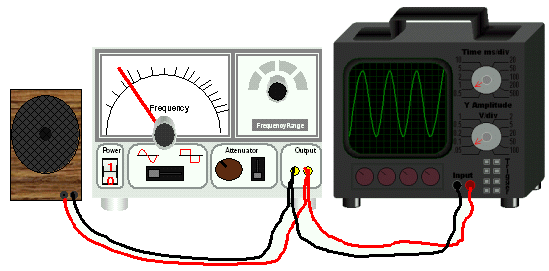School Science Experiment - Demonstrating the properties of waves on an Oscilloscope
|
|
Template:Wikibookspar
This is a School Science Experiment for demonstrating the properties of waves on an Oscilloscope. The following standard demonstration is used in many schools and colleges to show the basic principles of waves.
Setting Up
A signal generator is connected to an oscilloscope and a loudspeaker. Some signal generators have two outputs:
- one marked with a low value impedance e.g. 8 Ω
- the other marked with a high value e.g 600 Ω.
In this case the high impedance output goes to the oscilloscope, the low to the speaker. If there is only one output connection, stackable 4mm plugs are used to connect both devices to the signal generator.
The oscilloscope is adjusted so that there is a clear sine wave trace that occupies about half the screen height and has two or three clear waves visible when the signal generator is set at a medium frequency and mid volume.
Demonstrating the Amplitude and Frequency
The advantage of setting the demonstration up in this manner, over the more traditional method of plugging a microphone into the input of the scope, is that the signal generator produces perfect sine waves, which keeps everything nice and straightforward.
- By changing the frequency of the signal generator, the effect can be seen as more complete waves on the screen correspond to a higher pitch of the sound.
- By changing the amplitude (volume) of the signal generator, the amplitude of the waveform on the scope can be seen to change and the loudness of the speaker sound changes.
See also
- Demonstrating properties of waves with a ripple tank
- free audio software to view and generate signals


